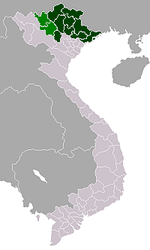Hiệp Hòa District
| Hiệp Hòa District Huyện Hiệp Hòa | |
|---|---|
| Rural district | |
| Country |
|
| Province | Bắc Giang |
| Capital | Thắng |
| Area | |
| • Total | 78 sq mi (201 km2) |
| Population (2003) | |
| • Total | 210,980 |
| Time zone | UTC + 7 (UTC+7) |
| Website | bacgiang.gov.vn/huyenhiephoa |
Hiệp Hòa is one of nine rural districts of Bắc Giang Province in the Northeast region of Vietnam. As of 2003 the district had a population of 210,980.[1] The district covers an area of 201 km². The district capital lies at Thang.[1] This is the homecountry of Trạng nguyên Đoàn Xuân Lôi of the Trần Dynasty, Tiến sĩ Trịnh Ngô Dụng of the Lê Dynasty, Đình nguyên Nguyễn Đình Tuân of the Nguyễn Dynasty.
Geography
Hiep Hoa District borders to the north with Tân Yên District to the south with Yên Phong District, to the east with Viet Yen District, and to the west with Thái Nguyên Province and Sóc Sơn District of Ha Noi.
- The total natural land area of the district is 20,110 hectares
- Agricultural land is 13,479 hectares or 67%;
- Forest land occupies 190.3 ha or 0.9%
- Unused land occupies 1,653.2 ha or 8.2% ...
Land type varies and is suitable for different types of [griculture; the district also supports industry.
Administrative divisions
The district is divided into one township (thị trấn) Thắng, and 25 communes (xã): Bắc Lý, Châu Minh, Đại Thành, Danh Thắng, Đoan Bái, Đông Lỗ, Đồng Tân, Đức Thắng, Hòa Sơn, Hoàng An, Hoàng Lương, Hoàng Thanh, Hoàng Vân, Hợp Thịnh, Hùng Sơn, Hương Lâm, Lương Phong, Mai Đình, Mai Trung, Ngọc Sơn, Quang Minh, Thái Sơn, Thanh Vân, Thường Thắng, and Xuân Cẩm.
Topography
Hiệp Hòa is topographically uneven, with hills and low mountains in some communes in the north, the Red River Delta in the east and generally sloped from the northwest to the southeast.
Climate
The weather is influenced by the tropical monsoon, average temperature is 23-24 degrees C, and average annual rainfall 1500 mm.
Natural resources
Forest
The district has a lack of natural forest; forest plantings have been accomplished in seven communes, totalling 167 hectares.
Sand and gravel
The district has resources of construction industry-quality sand and gravel.
Water
Hiệp Hòa's water supply for agricultural use is plentiful, drawn from ponds and the Cầu River system.
Infrastructure
Electricity
By 2003 the national electricity grid has covered 26 of 26 towns and reached 100% of villages. The district now has 124 transformers with capacity of 16,525 kVA.
Water
Residents mainly use water from well], as well as natural river water and rainwater. The district has 34,788 wells. 2600 households are using natural river water. Overall about 70% of the population have water in the toilets. Currently, the water project in Quang Minh is in the process of funding and construction.
Transportation
District Highway 37 runs 14 km in-district; 3 provincial highways - Road 295, Road 296 and Road 367 - have a total length of 39.6 km. Roads linking communes total 103.2 km and roads linking villages and hamlets total nearly 600 km. Highways and provincial roads are 100% paved.
Communication
Each commune has a post office in the commune cultural center. Many households and every village have a telephone. Daily newspapers and magazines enjoy good circulation.
Manpower
The 2006 district population was more than 300,000 people; people of labor age total 133,650 people or 44.8% of the population. The proportion of agricultural workers, though still large, has been reduced as industrialization and the development of industrial parks continues apace.
References
- ↑ 1.0 1.1 "Districts of Vietnam". Statoids. Retrieved March 13, 2009.
Coordinates: 21°19′59″N 105°58′01″E / 21.333°N 105.967°E
